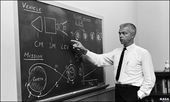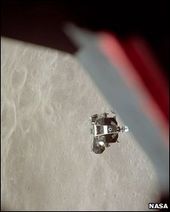
The moonshot architecture took a while to emerge
Exactly 40 years ago, Apollo 10 blasted off Earth; its mission in the words of Commander Tom Stafford "to sort out the unknowns and pave the way for a lunar landing". Continuing his series of essays marking the 40th anniversary of the moonshots, Dr Christopher Riley reflects on Nasa's method for landing on the Moon and the Apollo legacy of space rendezvous.
"In May 1969, with only seven months to go before the end of the decade, the first Lunar Module to fly in orbit around the Moon was powered up and readied for undocking from the Command Module.
Astronauts Tom Stafford, John Young and Gene Cernan were about to test out a technique for lunar landing which had first been proposed in 1916 by a Russian mechanic called Yuri Kondratyuk.
Kondratyuk's thesis described how a small landing craft could leave a mothership in lunar orbit to ferry its crew to the surface and back - a technique later referred to as Lunar Orbit Rendezvous or LOR.
Forty years after Apollo it's easy to see this method of landing a man on the Moon as the only way it could have been done. But the idea of bringing two vehicles together in space above the Moon had originally been rejected outright by Nasa as simply too difficult.
In 1961, with Kennedy's challenge still ringing in their ears, the agency had favoured a far simpler approach.
From the 1950s, the principal concept for a flight to the Moon involved a streamlined rocket blasting vertically off the Earth, flying straight there and then landing vertically tail first on a column of rocket thrust.
After lunar exploration was completed, it would then perform a similar vertical launch from the Moon and a final vertical landing back on Earth.
Popular in both science fiction and with military feasibility studies at the time, this "Direct Ascent", as it was dubbed, also seemed an obvious solution for Apollo.

John C Houbolt explains his space rendezvous concept for lunar landings
But Direct Ascent was not as straight forward as it first appeared. It would need a completely new and truly immense rocket called the Nova to do the job; four times more powerful than the Saturn V and perhaps as tall as the Empire State Building.
Secondly, no-one really knew how the astronauts, sitting near the top, could land this "flying skyscraper" on the lunar surface tail first.
Rocket pioneer Wernher von Braun had been championing an alternative concept called Earth Orbit Rendezvous (EOR) since his US Army days in the late 1950s.
His method would eliminate the need for one giant rocket, requiring instead a number of relatively smaller Juno V booster rockets, later to be known as Saturn Vs.
These would launch into orbit the collective hardware necessary to assemble a giant vehicle to travel on to the Moon and return to Earth.
But whilst EOR solved the problem of building a giant rocket on Earth, the difficulty of landing it on the surface of the Moon remained.
In addition, multiple Saturn V rocket launches would be needed for each Moon shot and so EOR would be expensive.
What von Braun and the others had missed was that it was not necessary for the entire spacecraft to land on the Moon. This had been Kondratyuk's breakthrough thought.

The ascent stage of the Apollo 10 Lunar Module just prior to docking
He realised that a smaller landing craft could be used to ferry the crew from the mothership in lunar orbit to the surface and back. This landing craft could then be discarded, leaving a much smaller and lighter craft to be propelled back to Earth.
Kondratyuk died in 1942, a generation before Apollo. But at least two space scientists, Herman Oberth and an Englishman named Harry E Ross, had kept Kondratyuk's ideas alive in the intervening years.
Then in 1958 an American called Thomas Dolan of the Vought Astronautics Division, doing some speculative work on lunar landing concepts, also resurrected it as a highly efficient-energy saving moonshot concept.
Whilst Dolan's company failed to win over Nasa, a young engineer called John Houbolt, working out of the Langley Space Flight Center, took up the baton in late 1960 - lobbying Nasa's top brass to adopt Lunar Orbit Rendezvous as the only realistic way of getting to the Moon by the end of the decade.
LOR had clear appeal - requiring only one Saturn V rocket per mission - but the rendezvous of two spacecraft had yet to be achieved in Earth orbit, let alone around the Moon.
And it took until June 1962, over a year after Kennedy's challenge had first been announced, before Nasa was persuaded that the challenge of a lunar orbit rendezvous was going to be easier than the alternative methods.
A new manned programme called Gemini was immediately announced to work out how to rendezvous in Earth orbit, but the first real proof of the LOR concept would have to wait for Apollo 10 in the spring of 1969.
A Lunar Module - nicknamed "Snoopy" would descend to about 50,000ft above the surface, scouting out the primary landing site for Apollo 11, before returning to the Command Module, "Charlie Brown", above.
The simplicity of this mission statement and the informal call signs for the spacecraft understated the complexity of such a flight. No one had ever attempted to rendezvous two spacecraft around another world; with its different gravity field and less familiar landmarks.
To undertake this challenge, Nasa had sent the most experienced crew ever to fly in space. Between them Stafford, Young and Cernan had flown on four different Gemini missions and together they had helped to pioneer the mechanics of orbital rendezvous flight above the Earth.

The space station owes a debt to the pioneers of space rendezvous
Now in lunar orbit and coasting along the trajectory it was designed for, Snoopy "buzzed" the Moon's mountain tops.
Stafford and Cernan standing shoulder to shoulder inside felt as if they were flying a nimble, responsive jet fighter.
The Lunar Module's unique, throttle-able descent engine gave the pilots unprecedented control over their wingless and airless flight. And with sixteen smaller engines to orientate themselves precisely in any direction, Snoopy was precisely crafted for its LOR mission.
As they came round for their final orbit, the astronauts prepared to return to Charlie Brown. Then, suddenly, without warning, Snoopy began to roll unexpectedly.
The incident, captured on 16mm film by a camera looking out of the window, startled the crew but Stafford quickly jettisoned the heavy descent stage and used his hand controllers to stabilise the tumble.
Back in control, Stafford and Cernan headed back up towards a radar-assisted rendezvous with Young inside the Command Module.
The docking and transfer accomplished, they jettisoned Snoopy's ascent stage, and headed for home. Apollo's path to the Lunar surface was clear.
Even before Stafford, Young and Cernan were back on Earth the next Moon ship was rolling out towards pad 39A; its destination - the Sea of Tranquility.
Befittingly for the craft which had flown such a historic and often overlooked mission, Snoopy's upper-stage still survives today in orbit around the Sun.
It drifts as an unseen monument to space rendezvous; the technique which not only made the Moon landings possible, but has permitted everything from the construction of our space stations to the latest Hubble Space Telescope servicing mission.
The gifts of Apollo are greater than we think."
Dr Christopher Riley produced and directed on the documentary feature film In the
Shadow of the Moon and curates the online Apollo film archive project
Footagevault. His book,
Apollo 11 - An Owner's Workshop Manual, will be published by Haynes later this month.
How many times must I read articles about sending humans beings to the moon when it has never been proven that the Van Allen belts can be safely crossed. In what way is this article relevant to the situation we face? Where are the (IMHO) necessary editorial caveats? This is propaganda and until SOTT or the scientific community can prove beyond a shadow of a doubt that man can transverse the Van Allen radiation belts safely this will continue to be propaganda.